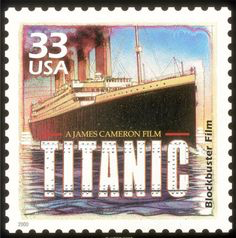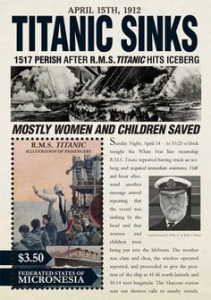Every Man for Himself – The Never Ending Story of the ERA – Equal Rights Amendment
 33 USA A James Cameron Film Titanic Blockbuster Film. 2000.
33 USA A James Cameron Film Titanic Blockbuster Film. 2000.
Every Man for Himself – The Never Ending Story of the ERA – Equal Rights Amendment © Irvan Moritzky
(Address given 14 Feb. 1977 to Bristow, Oklahoma Rotary)
Late in the evening of April 14, 1912 a large ocean liner was sailing on its maiden voyage from Liverpool, England to New York City. Since it was in the early spring, the weather was fairly nice in the North Atlantic with a bit of a breeze coming from the passage of the ship through the dark inky black waters. The Titanic was the proudest ship of the British White Star Company. It had been constructed so that it was virtually unsinkable. in that it had waterproof compartments to protect against any mishap in the open sea. There were several classes of passengers in the multi-deck ship and they enjoyed the various activities and parties that were planned for each of their assigned passages.  There were wood inlaid handrails, marble dancing floors, 30 piece orchestras with grand pianos, violins, clarinets, cornets, tympani, harp, French horns, cellos and basses. The passage of the liner was a very festive occasion because of its importance to the British passenger ships. It was even outfitted with the most modern equipment, including Marconi’s wireless radio which could keep in constant contact with the land based Coast Guard.
There were wood inlaid handrails, marble dancing floors, 30 piece orchestras with grand pianos, violins, clarinets, cornets, tympani, harp, French horns, cellos and basses. The passage of the liner was a very festive occasion because of its importance to the British passenger ships. It was even outfitted with the most modern equipment, including Marconi’s wireless radio which could keep in constant contact with the land based Coast Guard.
Ascension Island RMS Titanic the Departure, the Boat Deck, The Iceberg, The Sinking.
Titanic could receive news, weather and stock market summaries. Nevertheless fate struck the liner; going at nearly full speed, it collided with a large iceberg that sliced it open like a knife thru a  stuffed sausage roll. There was a football field long, 300 foot, tear under the water line through numerous compartments. As the ship began to fill, the captain realized the danger and hopelessness of the situation. The ship was inadequately equipped with lifeboats and life preservers; even though the wireless immediately began to broadcast the SOS throughout the area, help would still be many hours away. Because of the freezing water in the North Atlantic)a person could survive no longer than a few minutes in the open ocean.
stuffed sausage roll. There was a football field long, 300 foot, tear under the water line through numerous compartments. As the ship began to fill, the captain realized the danger and hopelessness of the situation. The ship was inadequately equipped with lifeboats and life preservers; even though the wireless immediately began to broadcast the SOS throughout the area, help would still be many hours away. Because of the freezing water in the North Atlantic)a person could survive no longer than a few minutes in the open ocean.
Titanic Canouan Grenadines of St. Vincent
The broadcast went out over the microphone and let’s imagine that this is the way it sounded ringing through the different decks:
 This is your captain speaking. I must report that the crew has been notified that we have hit an iceberg and the decision has been made to abandon ship. We have special instructions for the different nationalities. British, French and Italian shall go to the starboard, women and children first in the lifeboats. American citizens shall proceed to the port side and we have been notified that the 38th state has just ratified the 27th Amendment to the Constitution and the instructions are, “every man for himself.”
This is your captain speaking. I must report that the crew has been notified that we have hit an iceberg and the decision has been made to abandon ship. We have special instructions for the different nationalities. British, French and Italian shall go to the starboard, women and children first in the lifeboats. American citizens shall proceed to the port side and we have been notified that the 38th state has just ratified the 27th Amendment to the Constitution and the instructions are, “every man for himself.”
2012 Titanic Belgie, Francois Schuilen
 Now can you imagine. if your wife or children were on the Titanic and you were not there to look after their safety. Your reliance upon the crew of the White Star Line to outfit them in the life preservers and to assist in lowering the lifeboats to the open ocean? Can you imagine their helplessness if they were told “every man for himself?” In the tragedy of April 15, 1912 the Titanic sank in the North Atlantic with a loss of 1,517 lives. This would fully demonstrate the result of the Equal Rights Amendment. Gibraltar White Star Line 15th April 1912 Titanic The first life boat lowered to the sea, 15th April 1912 0020 hours
Now can you imagine. if your wife or children were on the Titanic and you were not there to look after their safety. Your reliance upon the crew of the White Star Line to outfit them in the life preservers and to assist in lowering the lifeboats to the open ocean? Can you imagine their helplessness if they were told “every man for himself?” In the tragedy of April 15, 1912 the Titanic sank in the North Atlantic with a loss of 1,517 lives. This would fully demonstrate the result of the Equal Rights Amendment. Gibraltar White Star Line 15th April 1912 Titanic The first life boat lowered to the sea, 15th April 1912 0020 hours
Perhaps I can provide a bit of history and background for the amendment. Such an amendment was first submitted to Congress in 1923, three years after women received the vote, but there was little pressure to do anything since the majority of feminists opposed it. They had a reason; the equal rights amendment would nullify protective laws which were hard won legislation, that gave the over-worked and under-paid factory woman something resembling decent working conditions. The act was again submitted in 1970 and a question of as to what “equal rights” meant was debated. This was answered by an article in the Yale Law Journal in 1971 by three students Barbara Brown, Ann Friedman and Gail Faulk, and Professor Thomas Emerson as to what “equal rights” should mean. They are all contemporaries of mine. The Congress seized upon Emerson’s article and adopted it as the official explanation of what “equal rights” should mean. It became the legislative history, carrying a great deal of weight as to its interpretive outcome.
This was answered by an article in the Yale Law Journal in 1971 by three students Barbara Brown, Ann Friedman and Gail Faulk, and Professor Thomas Emerson as to what “equal rights” should mean. They are all contemporaries of mine. The Congress seized upon Emerson’s article and adopted it as the official explanation of what “equal rights” should mean. It became the legislative history, carrying a great deal of weight as to its interpretive outcome.
Titanic 100 Aniversario, Mocambique
There are two issues proposed by equal rights supporters that the ERA is necessary to provide: protective legislation in the area of employment and business opportunities. We shall return to those, but first a summary of the activities of the Equal Rights Amendment will be appropriate. In an article in the July 1976 issue of McCall’s the author, Marilyn Mercer, asks the following questions and gave the answers in the text of the material. For your convenience, I am going to give you the answers immediately. If ERA becomes the law of the land, what will it mean?
 Will women lose their right to be supported by their husbands and, in the case of divorce, their claims to alimony and child support? Yes, they will lose their right to alimony but not to child support.
Will women lose their right to be supported by their husbands and, in the case of divorce, their claims to alimony and child support? Yes, they will lose their right to alimony but not to child support.
Will it mean no legal restraints on abortion?’ Yes.
Will public restrooms go coed? Yes.
Will women be drafted and assigned to combat duty in war? Yes.
Will wives be responsible for their husbands’ debts? yes.
Will it legalize homosexual marriages? Yes. The Supreme Court ruled on this about 2015.
Will widows lose their husband’s Social Security benefits? Yes, unless widowers will get the same benefits and there is enough money to go around.
The Equal Rights Amendment has generated substantial support and opposition by almost every group. The number of nationally known groups to oppose the ERA include the Knights of Columbus, the National Council of Catholic Women, the Church of Jesus Christ of Latter-day Saints, the Daughters of the American Revolution, the Women’s Christian Temperance Union, the John Birch Society and the American Communist party. This was as of the time the ERA was actively being considered, to wit before 1982.
Those that support the Equal Rights Amendment argue that it is necessary to obtain equal pay for equal work. But, there has been no demonstration that any sex discrimination in employment is not remediable under Title 7 of the Civil Rights Act of 1964.
The discussion of the Equal Rights Amendment has based itself mostly upon the concept of the rights of women in job discrimination and equal employment opportunities. The legislative history (House Report #92-359) stated in the words of Representative Emanuel Celler: Discrimination against women does exist. Of that there is no denial. Let it be understood that opposition to the Equal Rights Amendment is not to be equated with condoning practices or patterns of discrimination. The dissent runs not against the purpose of the Equal Rights Amendment but against the method.
The report is as revealing in matter not alluded to as it is in issues covered. No proponents of the Amendment explain in what manner current legislative power fails to provide all the remedy necessary to correct the wrongs listed.
The Department of Justice stated -Even if one were to determine for himself that all of these differences in treatment ought to be abandoned, under a federal system such as ours, the questions would remain as to whether a unitary rule should be promulgated by constitutional amendment which would deny to each state the right to choose for itself among rational alternative policies.
For instance there is no dispute that the ERA will mandate the drafting of women on the same basis as men should another mandatory draft be adopted. This is defended in the ERA literature on the basis that either women want to fight, as demonstrated by the Russian, Israeli and other European women, or that women would be as much exempt from the draft as men, and that the fear that mothers will be conscripted from their children is totally unfounded unless Congress sought to do so. If you will recall that during Vietnam the fathers with one child were draftable, and I-believe that during World War II fathers with two children were subject to the draft. Thus mothers with two children would also be subject to the draft.
If the ERA is passed there will undoubtedly be litigation. Individuals and groups with special interests may institute test cases. A gay liberation group, for instance, might claim that if the male homosexual cannot have a male spouse, that’s discrimination based on sex. Such was the argument when the Supreme Court ruled on the matter. The issue of homosexuality has been brought up and it has been receiving the support on the basis that it will guarantee homosexual legality. It didn’t need the ERA.
In the area of education, ERA will require that public schools and colleges be coeducational and have equalized admission standards for male and female students. It is alleged that private girls’ and boys’ schools would continue to exist, if they did not obtain tax exemptions or any federal funding. I’ll believe when I see it. Private colleges that received federal government funding would be required to hire male and female faculty members on an equal basis.
The issue is whether the law in New York would be the law in Oklahoma, the rules in California would be the rules in Louisiana.
 Representative Edward Hutchinson expressed the issue in this manner: “Legislative power already exists to strike down every vestige of inequality between the sexes. A Constitutional amendent is not needed either to create that power, to extend it, or to perfect it. If any inequality between the sexes still exists in the law and public policy demands complete equality, then why not remove those inequalities legislatively? The proponents of the constitutional amendment answer the question by expressing their impatience with the piecemeal approach of the legislative process. They want to remove all inequalities at one time by denying the power of government to recognize any inequality. What they apparently fail to see is that they are simply trading one piecemeal approach for another. Instead of working with state legislatures and the Congress to write laws, amend laws, and repeal laws to remove such vestigial inequalities as yet remain, they will be suing in the courts to define the word equality, case by litigated case. All they will have accomplished is to change the form from the legislature to the courts. The phrase ‘equality of rights under the law’ will mean whatever the Supreme Court says it means, and that meaning may change from time to time as the membership of the court changes. In fact, it is not beyond the realm of possibilities that the court may find, sometime in the future, that by this amendment, particularly the second section thereof, Congress was vested with power to take from the states the whole body of domestic relations law and perhaps part of their property law as well.
Representative Edward Hutchinson expressed the issue in this manner: “Legislative power already exists to strike down every vestige of inequality between the sexes. A Constitutional amendent is not needed either to create that power, to extend it, or to perfect it. If any inequality between the sexes still exists in the law and public policy demands complete equality, then why not remove those inequalities legislatively? The proponents of the constitutional amendment answer the question by expressing their impatience with the piecemeal approach of the legislative process. They want to remove all inequalities at one time by denying the power of government to recognize any inequality. What they apparently fail to see is that they are simply trading one piecemeal approach for another. Instead of working with state legislatures and the Congress to write laws, amend laws, and repeal laws to remove such vestigial inequalities as yet remain, they will be suing in the courts to define the word equality, case by litigated case. All they will have accomplished is to change the form from the legislature to the courts. The phrase ‘equality of rights under the law’ will mean whatever the Supreme Court says it means, and that meaning may change from time to time as the membership of the court changes. In fact, it is not beyond the realm of possibilities that the court may find, sometime in the future, that by this amendment, particularly the second section thereof, Congress was vested with power to take from the states the whole body of domestic relations law and perhaps part of their property law as well.
 Proponents want to leave all of these policy decisions to the courts. I believe they should be left in the legislatures and in the Congress, and the way to leave them here is to defeat this amendment.”
Proponents want to leave all of these policy decisions to the courts. I believe they should be left in the legislatures and in the Congress, and the way to leave them here is to defeat this amendment.”
The absolutist nature of the ERA is such that Professor Paul Freund of the Harvard Law School testified before the Senate Judiciary Committee, “Indeed, if the law must be as indiscriminating concerning sex as it is toward race, it would follow that laws outlawing wedlock between members of the same sex would be as invalid as laws forbidding the miscegenation. Whether the proponents of the amendment shrink from, these implications’ is not clear.” Professor James White of Michigan Law School said; “Conceivably a court would find that the state had to authorize marriage and recognize marital legal rights between members of the same sex.” The courts do so.
Senator Sam J. Ervine, Jr. added: “This matter illustrates as well as any of the radical departures from our present system that the ERA will bring about in our society.” A later study in the Yale Law Journal in January 1973 shows clearly that the Equal Rights Amendment will authorize homosexual marriages because of the ERA’s stringent requirements that sex is to be an impermissible legal classification.”
This issue of homosexuality has been glossed over by some supporters of the ERA on the grounds that these are technicalities which are not reasonably to be tolerated in our society.
Nevertheless, at the time of the 16th Amendment concerning the legalization of the income tax, Joseph Hodges Choate went to the Senate committee and requested that they add a 10% limit to the amendment that was being proposed. The reaction of the Senators was, “Don’t insult our intelligence, we are only asking for a 1% tax, and the 10% limitation is absolutely unnecessary. If we cap it at 10%, people will think we want a 10% tax. Never going to happen.” Within five years after the adoption of the income tax amendment, the rate had increased to 65%. Later the rate was to vary as high as 90% during World War II. The Senators who felt insulted by these requests, were misunderstanding the potentiality of their laws, or were liars. They needed an eternal vision, they needed to imagine the sinking of the Titanic, and the option of saving women and children first. The issue of any Equal Rights Amendment certainly merits everyones earnest study. I have a daughter aged 32 months who will be of draftable age for the next war. It is difficult enough to imagine the strains on the family when the sons are in combat, but to include wives and daughters is unfathonable.
USA Today ran a column on the Equal Rights Amendment on October 12, 2018. Congress set a time limit for ratification of 1982, which came and went without obtaining the necessary 38 states. Some states withdrew their ratification before 1982. Since 1982, 2 states Nevada and Illinois ratified the ERA in its a moribund status.
‘’ Congress passed the amendment in 1972, but it wasn’t ratified by the requisite number of states – 38 – by an extended deadline in 1982. Conservative groups argued it was unnecessary and would overturn laws or programs that benefit women.
Four state legislatures voted to rescind their ratification (Kentucky’s rescission was vetoed). South Dakota passed a resolution declaring its ratification void if the national deadline passed.
There’s no case law saying a ratification can be “undone,” according to Winston & Strawn, a law firm that supports the ERA. A federal court held in 1981 that a state could rescind its ratification of the ERA, but the Supreme Court vacated the decision once the ERA deadline passed and the appeal became moot, according to the firm.
It’s unclear how Kavanaugh would vote on such issues. He didn’t give a definitive answer when ERA advocate Sen. Dick Durbin, D-Ill., asked in writing whether Kavanaugh believes the ERA should be added to the Constitution. *** Democrats have pushed legislation to either remove the ratification deadline or start over, but both proposals have languished.’’
USA Today’s 2018 explanation of the ERA was without reference to the 1972 legislative history, previously noted. But for something nearing a century old, that it came up in Senate Judiciary Hearing confirming a Supreme Court nominee, suggests the issue is the never ending story.
What will the American law be, women and children first? Or every man for himself? This issue merits your independent and earnest study. I end this with a statement from Bernard M. Baruch, “Every man has a right to his opinion, but no man has a right to be wrong in the facts.”
Disclaimer: The author of each article published on this web site owns his or her own words. The opinions, beliefs and viewpoints expressed by the various authors and forum participants on this site do not necessarily reflect the opinions, beliefs and viewpoints of Utah Standard News or official policies of the USN and may actually reflect positions that USN actively opposes. No claim in public domain or fair use. © Edmunds Tucker. UTopiAH are trade marks of the author. Utopia was written in 1515 by Sir Thomas More, Chancellor of England.
Utah Standard News depends on the support of readers like you.
Good Journalism requires time, expertise, passion and money. We know you appreciate the coverage here. Please help us to continue as an alternative news website by becoming a subscriber or making a donation. To learn more about our subscription options or make a donation, click here.
To Advertise on UtahStandardNews.com, please contact us at: ed@utahstandardnews.com.


Comments - No Responses to “Every Man for Himself – The Never Ending Story of the ERA – Equal Rights Amendment”
Sure is empty down here...